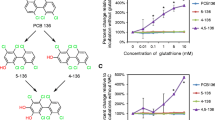Abstract
The metabolism of pentachlorophenol has been studied in the rat after pretreatments with phenobarbital, 3-methyl-cholanthrene or 2,3,7,8-tetrachlorodibenzo-p-dioxin (TCDD). In addition to the previously identified metabolite, tetrachloro-p-hydroquinone, trichloro-p-hydroquinone has been identified in urine as a metabolite. The formation of the latter represents a type of dechlorination different from that of the formation of tetrachlorohydroquinone. The inducing agents, 3-methylcholanthrene and TCDD have similar effects on the dechlorination and increase the formation of tetrachloro-p-hydroquinone more pronounced than does phenobarbital. In contrast to phenobarbital they also increase the formation of trichloro-p-hydroquinone and the total elimination of pentachlorophenol and its metabolites. The in vivo findings are supported by in vitro studies with microsomes from rats pretreated with phenobarbital or TCDD. Use of the inhibitor β-diethylaminoethyl-diphenyl propylacetate (SKF 525-A) in vitro showed a more pronounced inhibition on microsomes from phenobarbital-treated rats than on microsomes from untreated or TCDD-treated rats.
Gas chromatography-mass spectrometry have been used for the identification and quantification of pentachlorophenol and its metabolites.
Zusammenfassung
Der Metabolismus von Pentachlorphenol nach Vorbehandlung der Versuchstiere (Ratten) mit phenobarbital, 3-Methylcholantren oder 2,3,7,8-Tetrachlordibenzo-p-Dioxin (TCDD) ist untersucht worden. Zu dem schon früher nachgewiesenen Metaboliten Tetrachlor-p-Hydrochinon wurde nun auch Trichlor-p-Hydrochinon als Harnmetabolit festgestellt. Die Bildung des letzteren stellt eine andere Art von Dechlorierung dar als diejenige die bei der Entstehung von Tetrachlor-p-Hydrochinon vorliegt. 3-Methylcholantren und TCDD haben ähnlichen Einfluß auf die Dechlorierung und steigern die Bildung von Tetrachlor-p-Hydrochinon mehr ausgeprägt als es bei phenobarbital der Fall ist. Im Gegensatz zu phenobarbital steigern sie auch die Bildung von Tri-chlor-p-Hydrochinon sowie die totale Eliminierung von Pentachlorphenol und von Metaboliten. Die in vivo-Befunde werden von in vitro-Studien mit Mikrosomen von mit phenobarbital oder TCDD vorbehandelten Ratten gestützt. Anwendung des Inhibitors β-Diethylaminoethyl-Diphenyl-Propylacetat (SKF 525-A) zeigte in vitro eine ausgeprägtere Inhibition der Mikrosomen von mit phenobarbital behandelten Ratten als der Mikrosomen von unbehandelten oder TCDD-behandelten Ratten. Nachweis und Bestimmung von Pentachlorphenol und seinen Metaboliten wurden gaschromatographisch-massenspektrometrisch durchgeführt.
Similar content being viewed by others
References
Ahlborg, U. G., Lindgren, J.-E., Mercier, M.: Metabolism of pentachlorophenol. Arch. Toxicol. 32, 271–281 (1974)
Ahlborg, U. G., Larsson, K.: Metabolism of tetrachlorophenols in the rat. Arch. Toxicol. 40, 63–74 (1978a)
Ahlborg, U. G., Larsson, K., Thunberg, T.: Metabolism of pentachlorophenol in vivo and in vitro. Arch. Toxicol. 40, 45–53 (1978b)
Chadwick, R. W., Freal, J. J.: The identification of five unreported lindane metabolites recovered from rat urine. Bull. Environm. Contamin. Toxicol. 7, 137–146 (1972)
Engst, R., Macholz, R. M., Kujawa, M., Leverenz, H.-J., Plass, R.: The metabolism of lindane and its metabolites gamma-2,3,4,5,6-pentachlorocyclohexene, pentachlorobenzene and pentachlorophenol in rats and the pathways of lindane metabolism. J. Environm. Sci. Health B11 (2), 95–117 (1976)
Greig, J. B., De Matteis, F.: Effects of 2,3,7,8-tetrachlorodibenzo-p-dioxin on drug metabolism and hepatic microsomes of rats and mice. Environm. Health Perspect. 5, 211–219 (1973)
Jacobson, I., Yllner, S.: Metabolism of 14C-pentachlorophenol in the mouse. Acta pharmacol. Toxicol. (Kbh.) 29, 513–524 (1971)
Koss, G., Koransky, W., Steinbach, K.: Studies on the toxicology of hexachlorobenzene. II. Identification and determination of metabolites. Arch. Toxicol. 35, 107–114 (1976)
Lucier, G. W., McDaniel, O. S., Hook, G. E. R., Fowler, B.-A., Sonawane, B. R., Faeder, E.: TCDD-induced changes in rat liver microsomal enzymes. Environm. Health Perspect. 5, 199–209 (1973)
Mannering, G. J.: Properties of cytochrome P-450 as affected by environmental factors. Qualitative changes due to administration of polycyclic hydrocarbons. Metabolism 20, 228–245 (1971)
Poland, A., Glover, E.: Chlorinated dibenzo-p-dioxins: Potent inducers of delta-amino-levulinic acid synthethase and aryl hydrocarbon hydroxylase 2. A study of the structure-activity relationship. Molec. Pharmacol. 9, 736–747 (1973)
Poland, A., Glover, E.: Comparison of 2,3,7,8-tetracholorodibenzo-p-dioxin, a potent inducer of aryl hydrocarbon hydroxylase, with 3-methylcholanthrene. Molec. Pharmacol. 10, 349–359 (1974)
Author information
Authors and Affiliations
Rights and permissions
About this article
Cite this article
Ahlborg, U.G., Thunberg, T. Effects of 2,3,7,8-tetrachlorodibenzo-p-dioxin on the in vivo and in vitro dechlorination of pentachlorophenol. Arch Toxicol 40, 55–61 (1978). https://doi.org/10.1007/BF00353279
Published:
Issue Date:
DOI: https://doi.org/10.1007/BF00353279




